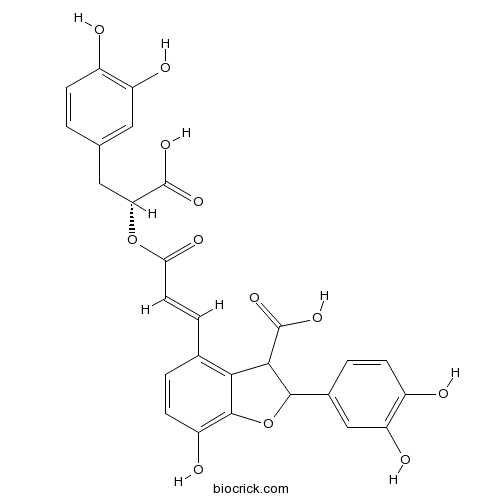InChI=1S/C27H22O12/c28-15-5-1-12(9-18(15)31)10-20(26(34)35)38-21(33)8-4-13-2-7-17(30)25-22(13)23(27(36)37)24(39-25)14-3-6-16(29)19(32)11-14/h1-9,11,20,23-24,28-32H,10H2,(H,34,35)(H,36,37)/b8-4+/t20-,23?,24?/m1/s1
Lithospermic acid (LSA) was originally isolated from the roots of Salvia mitiorrhiza ,
has antioxidant effects, is a competitive inhibitor of xanthine oxidase (XO), can directly scavenge superoxide and inhibit superoxide production in vitro, and presents hypouricemic and anti-inflammatory actions in vivo.[1]
Lithospermic acid has inhibitory effects on proliferation and migration of rat vascular smooth muscle cells.[2]
Lithospermic acid derivatives from Lithospermum erythrorhizon can increase expression of serine palmitoyltransferase in human HaCaT cells.[3]
Lithospermic acid possesses anti-HIV activity.[4]
Treatment with lithospermic acid B has a preventive effect on the development of diabetic retinopathy in this animal model, probably because of its antioxidative effects and anti-inflammatory effects.[5]
Lithospermic acid can attenuate 1-methyl-4-phenylpyridine-induced neurotoxicity by blocking neuronal apoptotic and neuroinflammatory pathways.[6]
Lithospermic acid has hepatoprotective effects against carbon tetrachloride-induced liver oxidative damage in vitro and in vivo.[7]
Lithospermic acid can attenuate mesenteric ischemia reperfusion injury in rat intestines by increasing tissue SOD and GPx activities and decreasing MDA and MPO levels, also improves morphological alterations which occurred after periods of reperfusion.[8]
English website: Lithospermic acid
Japanese website: Lithospermic acid
Chinese website: Lithospermic acid
[1] Liu X, Chen R, Shang Y, et al. Chem Bioll Interact, 2008, 176(2–3):137-42.
[2] CHEN, Wen-yi, WANG, et al. Acta Pharmacol Sin, 2009, 30(9):1245-52.
[3] Thuong P T, Kang K W, Kim J K, et al. Bioorg Med Chem Lett, 2009, 19(6):1815-7.
[4] Varadaraju T G, Hwu J R. Org Biomol Chem, 2012, 10(28):5456-65.
[5] Jin C J, Yu S H, Wang X M, et al. Plos One, 2014, 9(6):e98232-e98232.
[6] Lin Y L, Tsay H J, Lai T H, et al. J Biomed Sci, 2015, 22(1):1-13.
[7] Chan, Ho. Oncol Rep, 2015,34(2):673-80.
[8] Ozturk H, Terzi E H, Ozgen U, et al. Adv Clin Exp Med, 2012, 21(4):433-9.
[9] Yan L U, Sai-Wei W U, Dan-Hua X U. China j Chinese Materia Medica, 2015, 40(9):1744-6.



